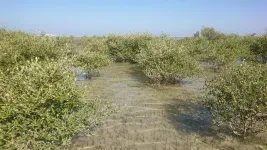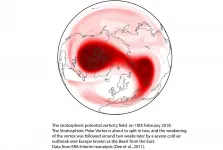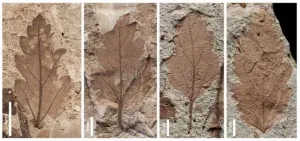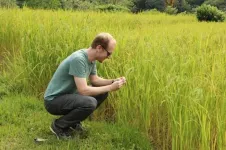INFORMATION:
Schneider's research was supported by the Alfred P. Sloan Foundation.
Editor's notes: To contact Jodi Schneider, email jodi@illinois.edu.
The paper "Continued post-retraction citation of a fraudulent clinical trial report, 11 years after it was retracted for falsifying data" is available online and from the U. of I. News Bureau.
DOI: 10.1007/s11192-020-03631-1
Retracted scientific paper persists in new citations, study finds
University of Illinois information sciences professor Jodi Schneider is leading an effort to prevent the spread of retracted research
2021-01-05
(Press-News.org) CHAMPAIGN, Ill. -- A small portion of scientific papers are retracted for research that is in error or fraudulent. But those papers can continue to be cited by other scientists in their work, potentially passing along the misinformation from the retracted articles.
Jodi Schneider, a professor of information sciences at the University of Illinois Urbana-Champaign who studies scholarly publications and how information gets used, is considering how scientific journals can better communicate about retracted articles. In a new study published in the journal Scientometrics, she found that a retracted clinical trial report continues to be cited 11 years after its retraction - and that citations actually increased after it was retracted.
Schneider's team reviewed citations of a 2005 paper in the field of respiratory medicine that found omega-3 fatty acids to be helpful in reducing inflammatory markers in patients with chronic obstructive pulmonary disease. The paper was retracted in 2008 for reporting on falsified clinical trial data.
However, it continues to be cited to support the medical nutrition intervention. Schneider's analysis covered 148 direct citations of the paper from 2006-2019 and 2,542 second-generation citations. The retraction was not mentioned in 96% of the 112 direct post-retraction citations for which she was able to study the context of the citation. The example demonstrates problems with how the current digital library environment communicates the retraction status of scientific papers, Schneider wrote.
The number of articles that are retracted "is really, really tiny. It's a regular occurrence that things get retracted, but people publish so much," Schneider said. Since 2012, there have been about four retractions per 10,000 publications, she wrote in her article.
When a new paper is published, most journals don't check the bibliographies for citations of retracted research. "It's really rare for any journal to be scanning reference lists," Schneider said.
Notices of retractions are often hard to find. Some websites and databases, such as PubMed, make retraction notices easily visible, but many others do not, Schneider said. There may be multiple sites where a copy of a scientific paper can be found, and not all will indicate if it is retracted.
In addition, many databases don't have complete information about a retraction. Retractions can occur for a number of reasons, including errors made in the research or misconduct such as reporting fraudulent data. About 10% of retraction notices don't mention the reason for retraction, Schneider said.
"Part of the challenge is understanding the reasons why a particular article was retracted, which often are really vague," Schneider said.
How an article is cited matters - for example, whether authors seem aware of the retraction, whether they use the retracted paper as a foundation to build on with their own work or whether it is cited for a general concept or the history of research on a particular matter. Analyzing the context as well as the number of citations, Schneider found that more than 41% of the post-retraction citations of the respiratory medicine paper that did not mention the retraction also described the paper in detail.
"We looked at whether they were discussing the methods and results of the retracted paper. The more in-depth they are discussing it, the more they are using it as part of an argument for their work," she said.
Unlike with most retracted research articles, the respiratory medicine paper's citations increased substantially after the retraction, Schneider found. One likely factor influencing the number of citations the paper received is that it was the first purported random clinical trial on a research question with very little previous research, she said.
The retraction process can take a long time and involve institutional or governmental investigations, she said. The longer it takes to retract an article that is in error or fraudulent, the more likely it is to be cited in the meantime.
"The current information environment facilitates the spread of research papers, but basic facts about these papers, such as their retraction status, do not spread as swiftly as the PDFs or citations to these papers themselves. Our case study suggests that unknowing and likely unintentional citation of retracted papers could be common, and that post-retraction citation may be correlated with visibility of retraction status," Schneider wrote.
She has led several workshops for people across scholarly publishing to talk about how journals can better check for citation of retracted articles, and the workshop participants are drafting recommendations. Schneider said best practices for journals should include ensuring every retraction notice is publicly available and establishing a convention for how to flag an article that is retracted. Among the suggestions is developing a standard set of metadata regarding retractions that would be attached to articles and use a taxonomy of statuses, such as retraction or expression of concern.
Information sciences students at Illinois built a prototype tool called ReTracker that would automatically check for retractions among the articles that scholars compile in their online libraries, using data from PubMed, and add the retraction status directly into the library. Zotero, a popular reference-management software system used for managing bibliographic data and research materials, also has developed such a tool, Schneider said.
Ensuring that retracted articles don't continue to be cited as reliable research is important not just for scientists but also for public confidence in scientific research, Schneider said.
"A scientific paper that is right is like a brick to build walls of evidence we can rely on," she said.
ELSE PRESS RELEASES FROM THIS DATE:
Climate change caused mangrove collapse in Oman
2021-01-05
Most of the mangrove forests on the coasts of Oman disappeared about 6,000 years ago. Until now, the reason for this was not entirely clear. A current study of the University of Bonn (Germany) now sheds light on this: It indicates that the collapse of coastal ecosystems was caused by climatic changes. In contrast, falling sea level or overuse by humans are not likely to be the reasons. The speed of the mangrove extinction was dramatic: Many of the stocks were irreversibly lost within a few decades. The results are published in the journal Quaternary Research.
Mangroves are trees that occupy a very special ecological niche: They grow in the so-called tidal range, meaning coastal areas that are ...
Advanced materials in a snap
2021-01-05
ALBUQUERQUE, N.M. -- If everything moved 40,000 times faster, you could eat a fresh tomato three minutes after planting a seed. You could fly from New York to L.A. in half a second. And you'd have waited in line at airport security for that flight for 30 milliseconds.
Thanks to machine learning, designing materials for new, advanced technologies could accelerate that much.
A research team at Sandia National Laboratories has successfully used machine learning -- computer algorithms that improve themselves by learning patterns in data -- to complete cumbersome materials science calculations more than 40,000 times faster than normal.
Their results, published Jan. 4 in END ...
New clues to prostate cancer
2021-01-05
Australian research has identified a new mechanism in which prostate cancer cells can 'switch' character and become resistant to therapy.
These findings, just published in Cell Reports, are an important development in unravelling how an aggressive subtype of prostate cancer, neuroendocrine prostate cancer (NEPC), develops after hormonal therapies.
It is well established that some tumours show increased cellular 'plasticity' in response to new or stressful conditions, such as cancer therapy, says lead researcher Associate Professor Luke Selth, from the Flinders ...
Estimation of US SARS-CoV-2 infections, symptomatic infections, hospitalizations, deaths
2021-01-05
What The Study Did: Data from public health surveillance of reported COVID-19 cases and seroprevalence surveys were used in this observational study that reports an estimated 46.9 million SARS-CoV-2 infections, 28.1 million symptomatic infections, 956,174 hospitalizations and 304,915 deaths occurred in the U.S. through November 15, 2020.
Authors: Frederick J. Angulo, D.V.M., Ph.D., of Medical Development and Scientific/Clinical Affairs of Pfizer Vaccines, is the corresponding author.
To access the embargoed study: Visit our For The Media website at this link https://media.jamanetwork.com/
(doi:10.1001/jamanetworkopen.2020.33706)
Editor's ...
Imminent sudden stratospheric warming to occur, bringing increased risk of snow over coming weeks
2021-01-05
A new study led by researchers at the Universities of Bristol, Exeter, and Bath helps to shed light on the winter weather we may soon have in store following a dramatic meteorological event currently unfolding high above the North Pole.
Weather forecasting models are predicting with increasing confidence that a sudden stratospheric warming (SSW) event will take place today, 5 January 2021.
The stratosphere is the layer of the atmosphere from around 10-50km above the earth's surface. SSW events are some of the most extreme of atmospheric phenomena and can see polar stratospheric temperature increase by up to 50°C over the course of a few days. Such events ...
Novel method identifies areas most suitable for conservation of black lion tamarin
2021-01-05
By André Julião | Agência FAPESP - The black lion tamarin (Leontopithecus chrysopygus) once inhabited most forest areas in the state of São Paulo, Southeast Brazil, but currently occupies only some Atlantic Rainforest remnants there. In recent years, after various studies of the endangered species, environmental NGO Instituto de Pesquisas Ecológicas (IPÊ) moved groups of these animals to areas from which the species had disappeared.
Similar initiatives have now been reinforced by a group of researchers at IPÊ, São Paulo State University (UNESP) and the Federal University of Mato Grosso (UFMT), who cross-tabulated climate data and data on landscape (forest cover) to determine the sites best suited for future ...
Leaf fossils show severe end-Cretaceous plant extinction in southern Argentina
2021-01-05
The asteroid impact 66 million years ago that ushered in a mass extinction and ended the dinosaurs also killed off many of the plants that they relied on for food. Fossil leaf assemblages from Patagonia, Argentina, suggest that vegetation in South America suffered great losses but rebounded quickly, according to an international team of researchers.
"Every mass extinction event is like a reset button, and what happens after that reset depends on which organisms survive and how they shape the biosphere," said Elena Stiles, a doctoral student at the University of Washington who completed the research as part of her master's thesis at Penn State. "All the biodiversity ...
Remote sensing data sheds light on when and how asteroid Ryugu lost its water
2021-01-05
PROVIDENCE, R.I. [Brown University] -- Last month, Japan's Hayabusa2 mission brought home a cache of rocks collected from a near-Earth asteroid called Ryugu. While analysis of those returned samples is just getting underway, researchers are using data from the spacecraft's other instruments to reveal new details about the asteroid's past.
In a study published in Nature Astronomy, researchers offer an explanation for why Ryugu isn't quite as rich in water-bearing minerals as some other asteroids. The study suggests that the ancient parent body from which Ryugu was formed had likely dried out in some kind of heating event before Ryugu came into being, which left Ryugu itself drier than expected.
"One of the ...
Repeated ketamine infusions reduce PTSD symptom severity
2021-01-05
Repeated intravenous (IV) ketamine infusions significantly reduce symptom severity in individuals with chronic post-traumatic stress disorder (PTSD) and the improvement is rapid and maintained for several weeks afterwards, according to a study conducted by researchers from the Icahn School of Medicine at Mount Sinai. The study, published September XX in the American Journal of Psychiatry, is the first randomized, controlled trial of repeated ketamine administration for chronic PTSD and suggests this may be a promising treatment for PTSD patients.
"Our findings provide insight into the treatment efficacy of repeated ketamine ...
Protecting the global food supply chain
2021-01-05
As the world grows increasingly globalized, one of the ways that countries have come to rely on one another is through a more intricate and interconnected food supply chain. Food produced in one country is often consumed in another country -- with technological advances allowing food to be shipped between countries that are increasingly distant from one another.
This interconnectedness has its benefits. For instance, if the United States imports food from multiple countries and one of those countries abruptly stops exporting food to the United States, there are still other countries that can be relied on ...
LAST 30 PRESS RELEASES:
Electrodes created using light
Second-hand gift-giving is a well-deliberated decision
How human interaction drove evolution to make bears less aggressive
National Poll: Few parents offer teens guidance on healthy eating during holiday season
Cannabis derivatives could provide new ovarian cancer treatments
Raising strong yeast as a petroleum substitute
Clues to the origin of hot Jupiters hidden in their orbits
Canada’s reduced pledge to Global Fund will impact domestic health
1 in 4 children with major traumatic injuries not cared for in pediatric trauma centres
Duke and Duke-NUS’ joint cross-population research to uncover "East-West" differences in disease and care
Scientists to ‘spy’ on cancer- immune cell interactions using quantum technology breakthrough
Tech savvy users have most digital concerns
Making lighter work of calculating fluid and heat flow
Normalizing blood sugar can halve heart attack risk
Lowering blood sugar cuts heart attack risk in people with prediabetes
Study links genetic variants to risk of blinding eye disease in premature infants
Non-opioid ‘pain sponge’ therapy halts cartilage degeneration and relieves chronic pain
AI can pick up cultural values by mimicking how kids learn
China’s ecological redlines offer fast track to 30 x 30 global conservation goal
Invisible indoor threats: emerging household contaminants and their growing risks to human health
Adding antibody treatment to chemo boosts outcomes for children with rare cancer
Germline pathogenic variants among women without a history of breast cancer
Tanning beds triple melanoma risk, potentially causing broad DNA damage
Unique bond identified as key to viral infection speed
Indoor tanning makes youthful skin much older on a genetic level
Mouse model sheds new light on the causes and potential solutions to human GI problems linked to muscular dystrophy
The Journal of Nuclear Medicine ahead-of-print tip sheet: December 12, 2025
Smarter tools for peering into the microscopic world
Applications open for funding to conduct research in the Kinsey Institute archives
Global measure underestimates the severity of food insecurity
[Press-News.org] Retracted scientific paper persists in new citations, study findsUniversity of Illinois information sciences professor Jodi Schneider is leading an effort to prevent the spread of retracted research









